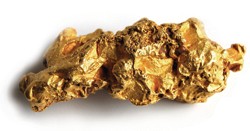End of Rainbow

By Terri Sota
If you are searching for gold, you’ll find it in some expected and not-so-expected places. In the Periodic Table, it is sandwiched between platinum and mercury, vertically linked with Group 11 members copper, silver and roentgenium. As one of 38 transition metals, gold has valence electrons – negatively charged particles that enable compound formation – housed in multiple energy shells. Elementally speaking, gold runs rings round its neighbors. Unlike prone-to-tarnish silver and copper, gold is notoriously non-reactive, yet is easily manipulated. It also conducts electricity, can be fashioned into wire, and melted, cast and alloyed (mixed) with other metals. It also may be pounded into thin sheets; a single gram of gold can be beaten into a wafer one meter square.
Throughout history, across many divergent cultures and civilizations, gold has reigned as a symbol of power, beauty and success. In scarce supply and both durable and portable, gold has been used as a medium for commerce for more than 6,000 years. In the United States, from 1900 to 1933, domestic currency was backed by a legislated “gold standard.” Every deposit, dollar or bond was literally worth its weight in gold; upon request, owners could convert their paper wealth into a fixed-price equivalent of cold hard gold.
While fancied for its luster, gold’s conductive properties are especially appealing to electronics manufacturers. It is ideal for use in low-voltage devices because it efficiently carries tiny currents without corruptive corrosion. It is used in connectors, switches, relays and soldered joints that comprise cell phones, global positioning systems, calculators and televisions. In computers, gold facilitates the flow of digital information; connectors used to mount chips and to attach cables all contain gold.
As prices fluctuate, so goes the demand for gold in dentistry. Its hypoallergenic inertness and malleability make it the perfect metal for the mouth. In medicine, radioactive isotopes of gold are used as a radiation source for treatment of cancers. Gold is also used for diagnostic testing (as a beta emitter) and in the manufacture of some surgical instruments.
Gold is found deep within the earth and miles above the planet. NASA uses gold in hundreds of different ways on each and every spacecraft it launches. Gold-coated polyester film, used to cover exterior surfaces, reflects infrared radiation and protects against heat absorption. The multi-faceted metal also serves as a lubricant, enabling the sliding of moving parts.
Classroom Discussion
- Where else is gold found (seawater, human body)?
- What happens to the gold supply when cell phones and other utilities are upgraded (and not recycled)?